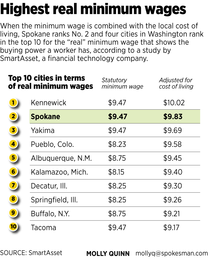
Jim Camden
The Spokesman-Review (August 24, 2015)
The paycheck of a worker making minimum wage goes further in Eastern Washington cities than anywhere else in the country, a new study by a personal finance technology company suggests.
The highest minimum wage in the nation, coupled with relatively low cost of living, make the Tri-Cities, Spokane and Yakima Nos. 1, 2 and 3 on the list of “real” minimum wages in 141 U.S. cities, according to SmartAsset. When the two are combined, Washington’s mandatory minimum of $9.47 an hour translates into buying power worth $10.02, $9.83 and $9.69, respectively, when compared with similar workers in other cities.
The survey ranks Tacoma and Vancouver at 10 and 11. Seattle’s current $11-an-hour wage puts that city at No. 37 overall, but when combined with the higher cost of living there, that hourly wage has a purchasing power of only $8.38. The Seattle City Council approved a phased-in $15-an-hour minimum wage in 2014.
With cities, states and the federal government discussing raising the minimum wage, the survey is a helpful way to look at that pay scale, said AJ Smith, of SmartAsset.
Cities where the federally mandated $7.25 an hour is the floor tend to be far down on the list, although there are some gaps in the survey that make it difficult to place other Inland Northwest cities.
To develop the list, SmartAsset used cost-of-living figures from a separate organization, the Council for Community and Economic Research. But the council relies on data supplied voluntarily from cities and didn’t have figures for cities in Idaho, Montana or several other states. Because of that, the cities listed aren’t the nation’s largest.
Doug Tweedy, a regional labor economist in Spokane, said a list that combines the two figures can be useful for workers trying to compare buying power when looking to relocate. It could be something communities could promote, he said, but they would have to devote some resources to do it correctly. The cost of living involves a wide array of items, from housing to gasoline to food to clothing; it changes over time: and consistency among the items studied in each city is important.
There is no shortage of lists, supplied by a wide array of sources, when one community pitches itself against another, said Robin Toth, the Greater Spokane Incorporated vice president for business development. GSI hadn’t seen the SmartAsset study, but the organization highlights Spokane’s lower cost of living when trying to attract new businesses or keep existing ones.
“When companies are looking to come to a new community, they definitely look at costs,” she said. The state’s minimum wage requirement is a higher cost, but a selling point could be that the higher buying power is a benefit to workers.
